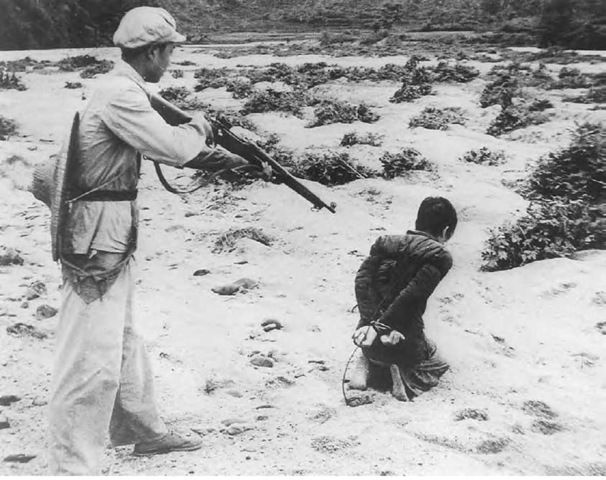Atrocity stories are a time-honored technique of propagandists, particularly in war propaganda. It is with the Crusades that the study of atrocity propaganda in wartime began. Pope Urban II (c. 1035—1099), in a sermon given at Clermont in 1095, justified the war against Islam by claiming that the enemy had ravaged the churches of God in the Eastern provinces, circumcised Christian men, violated women, and carried out the most unspeakable torture before killing them. Urban’s sermon succeeded in mobilizing popular enthusiasm for the People’s Crusade.
This atrocious image-the execution of a Chinese farmer by a Communist soldier—was circulated by the U.S. government overseas in the 1950s.
Powerful representations of martyrdom can be found in the sixteenth-century engravings in the Book of Martyrs (1556) by John Foxe (1516—1587), which depicted Catholic atrocities in graphic detail. In 1571 the Convocation of Canterbury decreed that the topic was to be placed, together with the Bishop’s Bible of 1568, in the house of every bishop, dean, and archdeacon. In the preface to the first edition Foxe claimed that he wished to reach “every man” and the “simple people.” In many ways the horrifically graphic portrayal of torture can be seen as the fore runner to the type of atrocity propaganda that one finds in the twentieth century. As religious propaganda the message disseminated by the engravings influenced anti-Catholic sentiments for generations and provoked bitter reprisals.
During World War I atrocity propaganda was employed on a global scale. Unlike previous wars, the Great War was the first total war in which whole nations and not just professional armies were locked in mortal combat. This and subsequent modern wars required propaganda to (1) mobilize hatred against the enemy; (2) convince the population of the justness of one’s own cause; (3) enlist the active support and cooperation of neutral countries; and (4) strengthen the support of one’s allies. Having sought to pin war guilt on the enemy, the next step is to make the enemy appear savage, barbaric, and inhumane. All the belligerents in World War I employed atrocity propaganda, and as a result stereotypes emerged that had been largely developed in the period leading up to the outbreak of war. The Germans referred to the British as the “perfidious Albion” and provided accounts of the Allied use of dum-dum bullets, mutilation, and brutality, as well as the use of “savages” from Africa and Asia to fight civilized peoples. The Germans also referred to the British naval blockade as an “atrocity.” Britain, however, is justifiably regarded as deploying atrocity propaganda with more intensity and more skill than most. Tales of the spike-helmeted German “Hun” cutting off the hands of children, boiling corpses to make soap, crucifying prisoners of war, and using priests as clappers in cathedral bells were widely believed by the British public, particularly after the Bryce Commission, which had been established to look into these claims, concluded that many were true. Both the British stereotype of the Hun and the French image of the Boche provided a platform for Allied propaganda to launch a moral offensive against a society founded upon militaristic values, thereby bringing home to its own populations the unimaginable consequences of defeat. Atrocity propaganda therefore played a major role in the wave of patriotism that enveloped Europe in the early stages of World War I.
In the years immediately following the conflict, various investigations, particularly in France and Britain, suggested that much of atrocity propaganda was false. As a result, atrocity propaganda was never used on the same scale in World War II. The British took the view that Nazism itself was an atrocity. In fact, much of British propaganda in World War II was characterized by the use of humor to deflate the enemy. The Nazis, however, had no such reservations and used atrocity propaganda whenever it was deemed appropriate. It was used extensively in Nazi anti-Bolshevik campaigns. Perhaps the most famous propaganda coup was the revelation of the Katyn massacre in 1943. Its repercussions led to the breaking off of diplomatic relations between the Soviet Union and the Polish government-in-exile. On 13 April German radio announced the discovery of a mass grave in the Katyn Forest near Smolensk, where Polish officers had been methodically killed. Both the press and the newsreels carried lurid accounts of the manner in which the Poles were slain, charging that Jewish officers of the Red Army were responsible for the murders. A documentary film entitled Im Wald von Katyn (In the Forest of Katyn) was also compiled and shown in all the major movie theaters in Germany and occupied Europe. There was a further tragic consequence of the atrocity stories of World War I. The discrediting of wartime propaganda and the revelations that few, if any, of the atrocity stories had been true led to a widespread disinclination on the part of the British and American public during World War II to believe real atrocity stories of extermination camps when they began to emerge from Nazi Germany.
In the post-1945 world, atrocity propaganda continued to figure prominently in all major modern wars, from Korea to Kosovo. In the Gulf War, for example, Western journalists focused on the Anfal—the Iraqi extermination of ethnic Kurds. Ethnic cleansing, as well as the atrocities that occur as a result of such polices, were strongly featured in the reporting of the Kosovo conflict. Both Albanians and Serbs employed atrocity stories to whip up xenophobic emotions—the surest method of eliciting from the masses savage patriotism that places the blame for every political folly or military action upon the head of the enemy.

